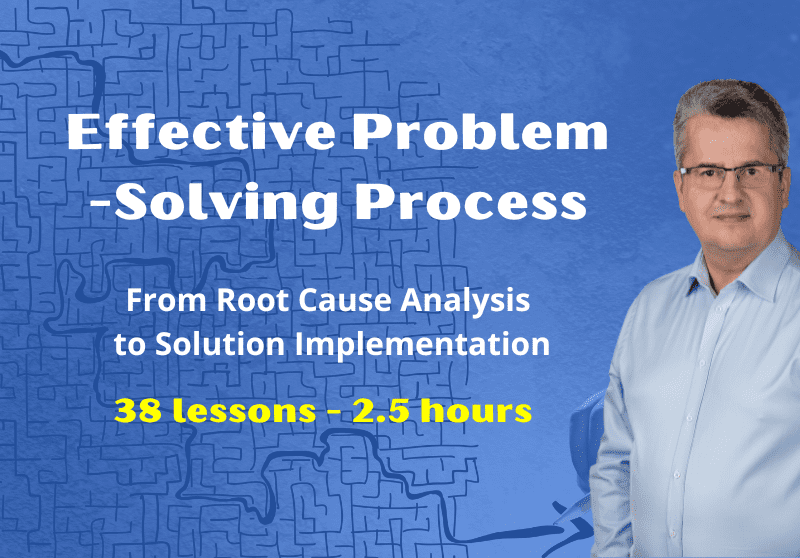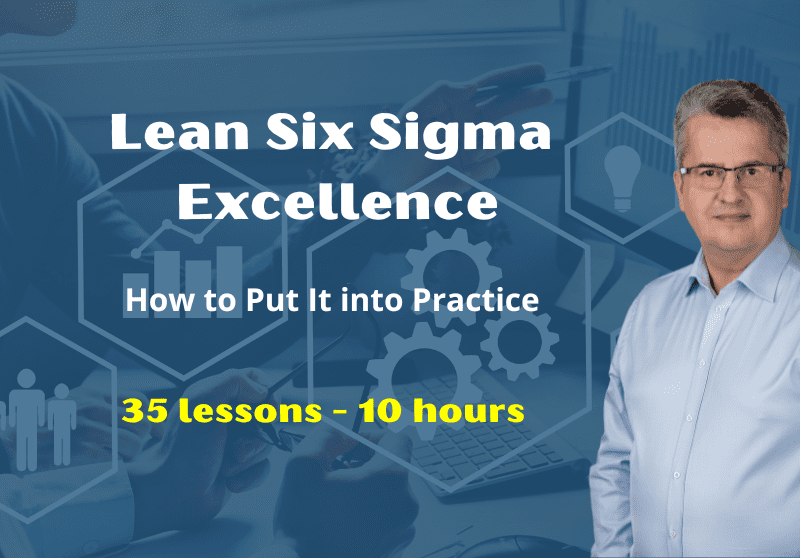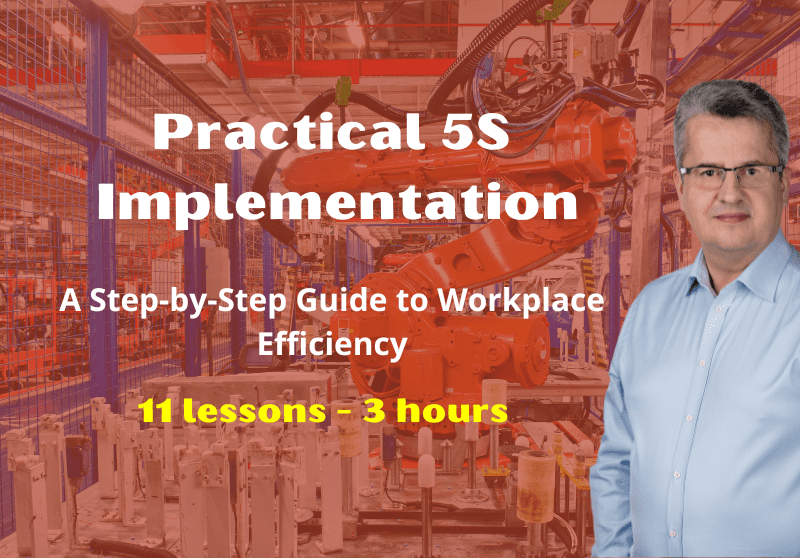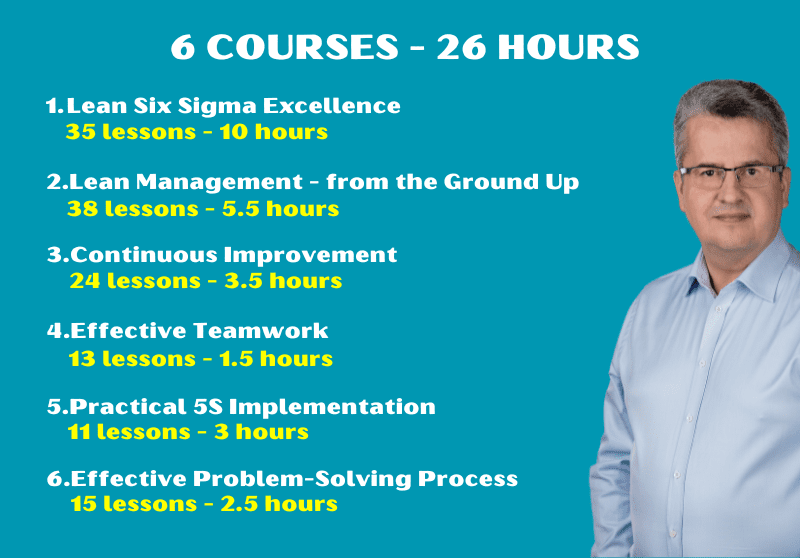What is Continuous Improvement? - 10,26 min
This lesson teaches continuous improvement and why it is important in organizations. It shows that every process can be improved, reducing costs, increasing efficiency, and improving quality. It highlights the importance of collaboration, engagement, and analysis in implementing changes. It also discusses barriers to improvement and ways to overcome them.
The Kaizen philosophy - 10,50 min
This lesson teaches the philosophy of Kaizen, which focuses on continuous, small daily improvements. It highlights the importance of involving all employees in the improvement process and concentrating on processes rather than just results. The lesson also covers the history of Kaizen, its practical applications, and its benefits, such as increased efficiency, better quality, and higher employee engagement. Ultimately, it emphasizes that Kaizen can be successfully applied in any industry.
History of Continuous Improvement - 9,24 min
This lesson explains the evolution of the continuous improvement philosophy from post-war Japan. It describes key methods such as Lean Manufacturing, developed by Toyota, and Six Sigma, introduced by Motorola. It also highlights the role of globalization and digital tools in optimizing processes. Finally, it emphasizes how modern technologies help companies achieve greater efficiency and quality.
Key Principles of Continuous Improvement - 11,52 min
This lesson explains the key principles of continuous improvement that help organizations achieve long-term benefits. It emphasizes process transparency, employee engagement, waste elimination, standardization, and customer focus. These principles ensure efficiency, consistency, and higher customer satisfaction. Ultimately, they guide organizations in making effective and sustainable improvements.
Common Mistakes in Approaches to Continuous Improvement - 9,42 min
This lesson covers common mistakes in approaches to continuous improvement. It aims to help organizations recognize and avoid these errors to ensure effective and sustainable progress. By mastering continuous improvement, businesses can optimize processes and achieve long-term success.
Types of Losses in an Organization - 10,41 min
This lesson introduces the fundamentals of loss analysis and explains an organization's different types of losses. It helps identify inefficiencies that hinder productivity and impact overall performance. Understanding these losses is essential for implementing effective continuous improvement strategies.
Tools for Identifying Losses - 9,34 min
This lesson focuses on tools for identifying losses within an organization. It provides methods to detect inefficiencies and areas for improvement. Understanding and applying these tools is essential for optimizing processes and enhancing performance.
Pareto Analysis - 7,34 min
This lesson covers Pareto Analysis, a method used to identify the most significant factors contributing to organizational losses. It helps prioritize issues by focusing on the vital few problems with the most important impact. Using Pareto Analysis enables organizations to make data-driven decisions and improve efficiency effectively.
Identifying Time-Related Losses - 9,35 min
This lesson focuses on identifying time-related losses in an organization. It highlights inefficiencies that waste time and reduce productivity. By recognizing these losses, businesses can optimize workflows and improve overall efficiency.
Assessing the Costs of Losses - 9,52 min
This lesson focuses on assessing the costs of losses within an organization. It helps quantify the financial impact of inefficiencies and wasted resources. Understanding these costs enables businesses to prioritize improvements and make informed decisions for greater efficiency.
Process Mapping - 10,57 min
This lesson introduces process mapping as a tool for continuous improvement. It helps visualize workflows, identify inefficiencies, and streamline operations. By mapping processes, organizations can enhance efficiency and make data-driven improvements.
Ishikawa Diagram (Fishbone Diagram) - 9,34 min
This lesson covers the Ishikawa Diagram (Fishbone Diagram), a tool for identifying the root causes of problems. It helps organizations analyze various factors contributing to inefficiencies. This method allows businesses to address issues and improve processes effectively and systematically.
Poka-Yoke – Error-Proofing - 6,40 min
This lesson introduces Poka-Yoke, an error-proofing technique used to prevent process mistakes. It focuses on designing systems that minimize human errors and enhance quality. Implementing Poka-Yoke helps organizations improve efficiency and reduce defects.
Data Visualization in Processes - 12,19 min
This lesson explores data visualization as a tool for continuous improvement. It highlights how visualizing data can help identify trends, monitor performance, and make informed decisions. Effective data visualization enhances process transparency and efficiency.
Creating Improvement Teams - 12,24 min
This lesson focuses on creating improvement teams within an organization. It highlights the importance of teamwork in driving continuous improvement. Businesses can foster collaboration, innovation, and long-term success by forming dedicated teams.
Employee Engagement - 10,40 min
This lesson focuses on employee engagement in the continuous improvement process. It highlights the importance of involving employees in decision-making and problem-solving. Engaged employees contribute to innovation, efficiency, and a substantial organizational improvement culture.
Creating a Culture of Continuous Improvement - 9,50 min
This lesson focuses on creating a culture of continuous improvement within an organization. It emphasizes the importance of leadership, employee involvement, and consistent efforts to drive positive change. Establishing this culture helps businesses achieve long-term growth and innovation.
Introduction to Six Sigma - 12,29 min
This lesson introduces Six Sigma, an advanced continuous improvement technique focused on reducing process defects and variability. It explains how data-driven decision-making enhances quality and efficiency. Six Sigma helps organizations achieve near-perfect performance through structured methodologies.
The DMAIC Cycle in Six Sigma - 12,19 min
This lesson explains the DMAIC cycle in Six Sigma, a structured approach to process improvement. It covers the five phases: Define, Measure, Analyze, Improve, and Control. DMAIC helps organizations identify and eliminate inefficiencies to achieve higher quality and performance.
Advanced Data Analysis - 10,32 min
This lesson explores advanced data analysis techniques for continuous improvement. It emphasizes using data to identify trends, optimize processes, and make informed decisions. Leveraging advanced analytics helps organizations enhance efficiency and drive innovation.
Planning Changes - 10,2 min
This lesson focuses on planning organizational changes as part of continuous improvement. It highlights the importance of strategic preparation, goal setting, and risk assessment. Effective change planning ensures smoother implementation and long-term success.
Change Management- 11,23 min
This lesson covers change management in the context of continuous improvement. It emphasizes strategies for successfully implementing and sustaining organizational changes. Effective change management helps minimize resistance and ensures long-term success.
Controlling and Maintaining the Effects of Changes- 5,15 min
Key Conclusions and Next Steps- 4,47 min






Shriram Bharathwaj –
Well structured content and to the point. Clear and articulate. The speed of narration is perfect.
Vanessa Houston (verified owner) –
A comprehensive guide equipping individuals and organizations with the knowledge and tools to drive continuous improvement, foster a culture of excellence, and achieve sustainable success.
Sree Vardhan Konidela (verified owner) –
This course is exceptional for anyone aiming to create sustainable progress in their organization. The instructor thoroughly explains key methodologies like PDCA, Kaizen, and Lean principles, making them easy to understand and apply.
Bagwati Dodiya (verified owner) –
Learn the principles and methodologies of continuous improvement to enhance productivity and efficiency. This comprehensive course provides practical tools for driving innovation and sustainable business growth. This was excellent, with good content.
Sudheer Divyakolu (verified owner) –
The lessons are well-structured, and the exercises help solidify the knowledge. Whether you’re new to process optimization or looking to refine your skills, this course is a valuable resource.
Gavin Stokes (verified owner) –
Excellent and very forceful workshop; highly recommended.
Raymond Dawson –
Great course, extremely informative.
Peter Co. –
A concise introduction to continuous improvement
Aric Logan Harper –
This training was refreshing. It emphasized that improvement doesn’t have to be huge to matter. The small steps example was inspiring. My team is already on board